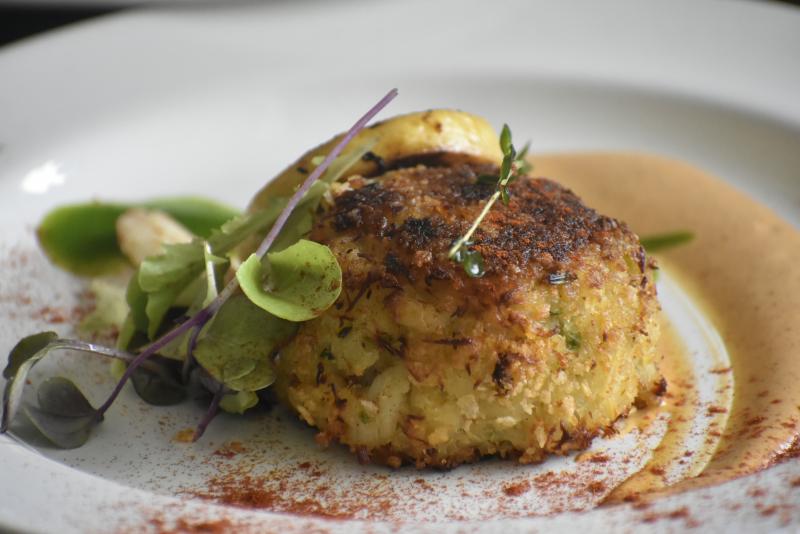
New state regulations may mean that Dungeness crabs won’t be in stores in time for Thanksgiving — again. The rules, aimed at preventing entanglements of endangered whales and sea turtles for the season starting on Nov. 15, could put the brakes on commercial fishing of the Bay Area crustaceans.
On Monday, the California Department of Fish and Wildlife published the new rules developed by a working group with representatives from environmental organizations and the fishing industry to prevent humpback whales, blue whales and Pacific leatherback sea turtles from getting caught and harmed in the fishing gear of the California commercial Dungeness crab fleet. Under these rules, which go into effect Nov. 1, the department’s director can close or limit fishing in certain areas when there is a higher risk of endangered whales or sea turtles getting harmed, depending on their migratory patterns.
If the season is going to be delayed, news could come next week, said Ryan Bartling, senior environmental scientist with the department.
“What we need to do is keep the fishery from interacting with those species,” said Bartling, who added that the new system has been in the works since 2017. “If there’s a number of them in the area or actual entanglements, the director can take an action to limit fishing.”
Last year, local crabbers decided to delay the local commercial crab season by a month until the risk of whale entanglement was lower, to Dec. 15, which meant no crabs during their traditional Thanksgiving debut then, either. But any delays this year will be mandated by the state.
Bartling conducts aerial surveys to check on the number of whales in fishing areas. The latest data from those surveys and also from the National Oceanic and Atmospheric Administration and other sources showed at least 20 whales in the Monterey Bay area, which could result in a delay of the season. Bartling will conduct two more surveys this week, and the number of whales spotted will determine whether the season will open on time so that locals can look forward to buying crab for Thanksgiving in the Bay Area. If 20 or more humpback whales are spotted in a fishing zone before the start of the season, for example, fishing can be delayed in that area.
The recreational crab fishing season, due to open Nov. 7, won’t be affected by the new rules.
In recent years, endangered whales and sea turtles have lingered closer to shore where crab fishermen drop their traps during the beginning and end of the season, which is usually in June. (There are indications that changes in migratory patterns have been caused by climate change, such as the warm “blob” or marine heat wave that lingered on the coast in 2014 and 2015.) The traps are attached to buoys on the surface by long lines that the animals can get caught in and become injured or die. In 2016, there were 71 confirmed whale entanglements in California, 22 of which were caused by Dungeness crab gear, according to NOAA.
Oakland’s Center for Biological Diversity sued the state in 2017 over the issue, a case that was settled in 2018 and required the state to have more oversight over entanglements. Previously, the state could issue an advisory to fishermen only when there was a risk of endangered species getting caught in their gear, rather than shut down the fishery, said Bartling.
Meanwhile, the number of entanglements has gone down since the height of 2016, dropping to only three known cases of whales entangled in California Dungeness crab gear in 2019, according to NOAA.
“I want to make sure it’s understood what kind of effort we’re putting into it as fishermen and how effective we’ve been,” said Dick Ogg, a Bodega Bay fisherman and a member of the California Dungeness Crab Fishing Gear Working Group that developed the rules. He said that fishermen have worked hard to make sure their gear is set up better to lower risk. “We’ve really reduced our interaction and entanglement rates.”
Ogg said there is a lot of anxiety in the fishing fleet about what will happen with the coming season and whether they should start gearing up for a Nov. 15 opening or whether it will be delayed. There’s a lot of uncertainty about how the state will respond to things like a high concentration of whales and turtles during different times of the season.
“There are a number of potential responses to when a trigger is activated, from an advisory to a closure, and that’s fully within the director’s discretion,” said Mike Conroy, executive director of the Pacific Coast Federation of Fishermen's Associations.
Geoff Shester of the conservation group Oceana, which was also part of the working group that developed the new rules, said a benefit of the new system is it allows the state to focus on certain areas where risk of entanglement is high and then leave open parts of the coast to fishing elsewhere.
“The department is trying to do a much more adaptive and active management of the fishery to allow more fishing to happen,” he said, adding that the state can also take other measures such as restricting the amount of fishing gear in an area.
Shester said the risk of entanglement is particularly high at the beginning of the season when hundreds of thousands of lines suddenly run from the ocean’s surface to the sea floor.
“Imagine yourself as a whale, swimming and eating. All of a sudden there’s all this gear. That’s the high-risk scenario we’re trying to avoid,” he said. “It’s trying to at least give the whales a chance to get out of the area.”
Tara Duggan is The San Francisco Chronicle’s assistant food editor. Email: tduggan@sfchronicle.com Twitter: @taraduggan
The Link LonkOctober 28, 2020 at 02:32AM
https://ift.tt/35JuNca
Bay Area Dungeness crab season might not open for Thanksgiving again. Here’s why - San Francisco Chronicle
https://ift.tt/2MkGRbk
Crab

No comments:
Post a Comment